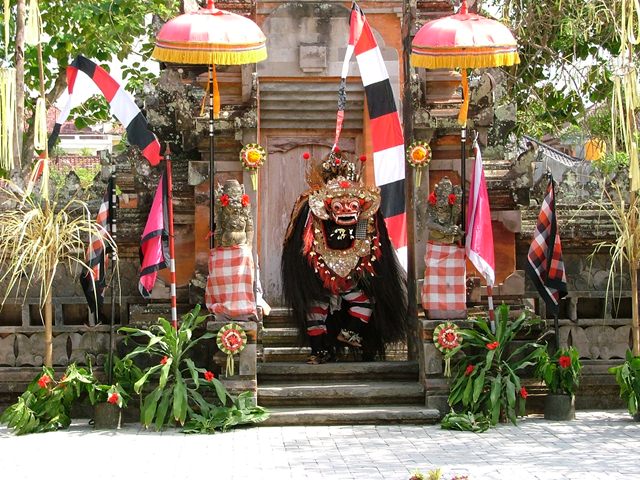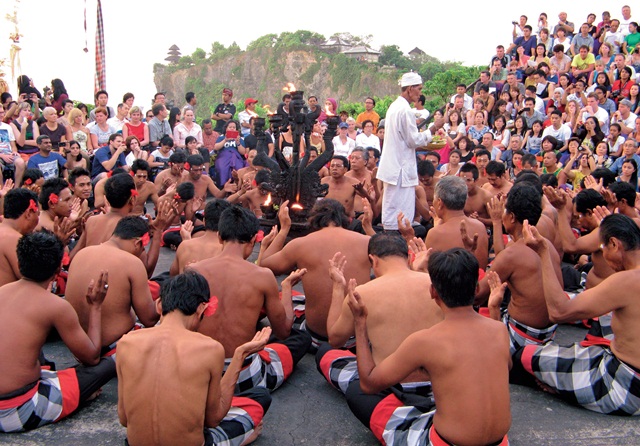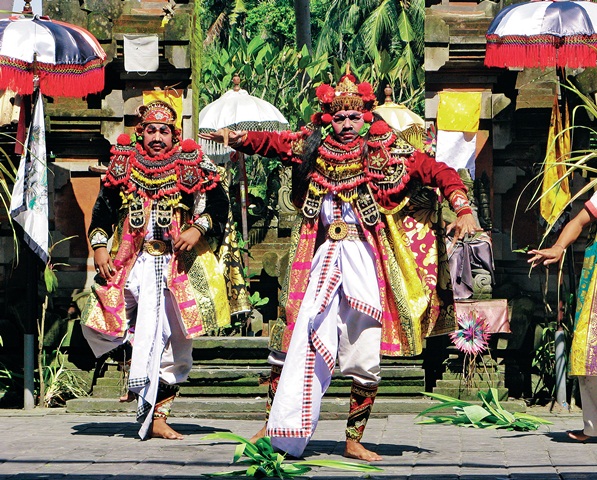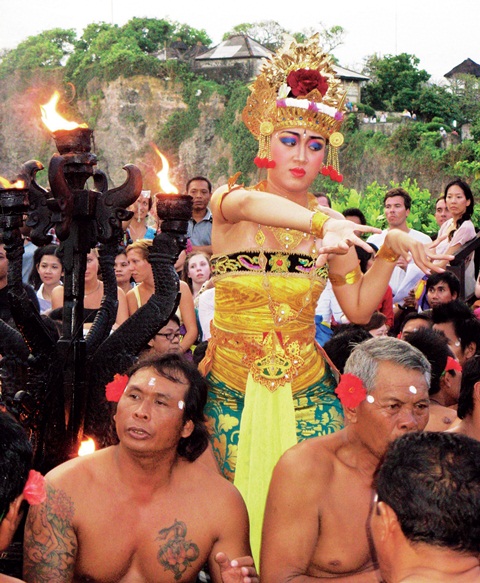
Dance is a major drawcard to Bali every year. Yet, beyond the graceful movements, intricate costumes, and tourist snapshots lies a spirituality that dates back centuries. Photojournalist Paula Tan captures these moments in a tale of reverence and living history.
In the flickering light of torches, the little blonde child, the youngest of the visitors here, sways to the rhythm, her dainty sandaled feet moving in a charming prelude to the Kecak performance. Here, in mystical Uluwatu, where the cliffs and ocean are bathed in the golden evening light, a dance to honour the gods is about to begin. As the dancers emerge, they emanate a sense of otherworldly power, an almost tangible link to the divine. Absolute in their faith, sinewy bodies begin to move and the chanting rises above the nowsilent crowd, transporting spectators to a realm of gods and demons.
Divine Connection

The life of Bali surfaces through the dances of its people. Apart from capturing how the Balinese view religion, each dance also reveals the flow of cultural events and everyday life. Performed during temple festivals and in ceremonies, it can be a channel for visiting gods or demons, with the dancers acting as a living repository – or an entertaining welcome for visiting deities. Dance goes as far back as Balinese written history, with much of its legacy originating from Java. With the arrival of Islam, Javanese culture slowly faded, but has somehow survived in Bali and become an inextricable part of its rich culture. Balinese dance is intertwined with its unique religion, and even dances for the tourists are always preceded by a small offering of food and flowers. Before performing, a dancer goes to pray at his or her family shrine to request holy inspiration from the gods. It goes unspoken that good must always triumph over evil in Bali, and no matter how many times one has seen the performance, nor how well they know the outcome, the battle remains all-important.
Throughout Bali’s many dances, the topic or episode performed is usually relevant to the occasion. During a wedding, a bridal tale will be performed, and at a death ritual, a hero’s visit to hell. Besides costumes, male and female roles are identified mostly by the accentuation of movements. Women’s legs are bent and pressed together, the feet apart, so as to reveal a sensual arching of the back. Men’s legs are arched and their shoulders pulled up, with sharper gestures, so as to exude an aura of power. The expressions are completed by mimicry of the face. Observe the dancers and you will see that even their eyes are dancing.
The Victor and the Vanquished

“Cak-cak-cak”: The steady chant of a choir from across the ages expands, filling the evening air. In the growing darkness, hundreds of bare-chested men sit in a circle around the fire, rocking to the rhythmic sound of their own voices; their hands raised to the sky, bodies shaking in unison. This is the unique Kecak, perhaps the most popular of all Balinese dances. Visitors rarely leave the island without seeing a Kecak performance. Originally, the Kecak was only an element of the older Sanghyang trance dance. Through the vision of expat painter Walter Spies, this religious chant was transformed into a dance with a narrative based on the Ramayana epic. The prince Rama, his wife Sita and his brother Laksmana are exiled to a forest. Rama hunts a golden deer at the request of his wife, who spotted the strange animal and requested that he catch it. While he is away, she is kidnapped by Rahwana who takes her to his island kingdom of Alengka (Sri Lanka). With help from the monkeys (the white monkey Hanuman in particular) Rama builds a bridge to Rahwana’s island where he defeats his wife’s kidnapper in a fierce battle and is reunited with his faithful Sita.
Maintaining the favoured theme of good over evil in Batubulan, the Barong dance, much like the Kecak, portrays a battle between good and evil spirits. The Barong can take various forms, but in this dance, he appears as the Barong Keket, the holiest of all Barongs. The Barong Keket is a strange creature, half shaggy dog-half lion, and is played by two men in much the same way as a circus clown-horse. His nemesis is the witch Rangda. The Barong personifies good and protects the village from her, but he is also mischievous and fun-loving. He flounces into the temple courtyard, dances around and enjoys the adulation of his keris-wielding supporters. However, at the sight of the hideous witch Rangda, the clown instantly transforms into a defender of the people. In a dramatic climax punctuated by the clang of the gamelan, Rangda is defeated. Yet, the end of the dance still leaves a large group of entranced Barong supporters to be restored to the real world. This is generally done by sprinkling them with holy water, sanctified by dipping the Barong’s beard in it. Performing the Barong and Rangda dance – immersed in powerful magic – is an operation not to be taken lightly. Extensive ceremonies must be undertaken, beginning with a temple priest on hand to end the dancers’ trance, and finally, a chicken has to be sacrificed to appease the evil spirits.
Everlasting Grace

To the sophisticated Balinese, the dance deemed most notable is the Legong, the most graceful of all. A Legong dancer is always a young girl – often as young as eight or nine and never older than her early teens. Such importance is attached to the dance that even in old age, a classical dancer will be remembered as a “great Legong,” even though her brief period of fame may have been over half a century ago. There are various forms of Legong, but the Legong Kraton, or Legong of the palace, is the one most frequently performed. Peliatan’s famous dance troupe, which visitors to Ubud often get a chance to see, is particularly noted for its Legong. A performance involves just three dancers – the two Legongs and their attendant known as the condong. The Legongs are identically dressed in tightly-bound gold brocade. Their faces are elaborately made up, their eyebrows plucked and repainted, and their hair adorned with frangipanis as they perform a delicate mirror image scene, nose-tonose.
The Legong dance relates how a king takes a maiden, Rangkesari, captive. When Rangkesari’s brother comes to rescue her, he begs the king to free her instead of fighting for her. The king refuses, and on his way to the confrontation, meets a bird of ill omen. He ignores it, and continues on his way to meet Rangkesari’s brother, who kills him. The dance however, only relates the lead-up to the battle and ends with the bird’s appearance. Here, the condong reappears with tiny golden wings as the bird of ill omen, and the dance comes to an end.
The Bali of today sets the gold standard in exotic tropical vacations. Amidst its fivestar resorts, clubs and surf shops, tanned physiques move to the contemporary rhythm of progress. Yet, all one has to do is to glance at any doorway, and on the floor sits little offerings to the gods. These tiny baskets of flowers, food and incense sticks are a reminder that, in the hearts of Bali’s people, the divine remains supreme. Here, on this isle of the gods, battles will continue to be fought and won every day, a constant renewal of faith through timeless stories of hope and light over darkness.
Source: The Expat December 2013
Read more:
- A Place Called Pemuteran: Bali’s Laid-Back Gem
- An Expat’s Tale on Exploring Lombok, the Other Kuta in Bali
- An Expat’s Reflection on Bali
What are your thoughts on this article? Let us know by commenting below.No registration needed.
"ExpatGo welcomes and encourages comments, input, and divergent opinions. However, we kindly request that you use suitable language in your comments, and refrain from any sort of personal attack, hate speech, or disparaging rhetoric. Comments not in line with this are subject to removal from the site. "
















